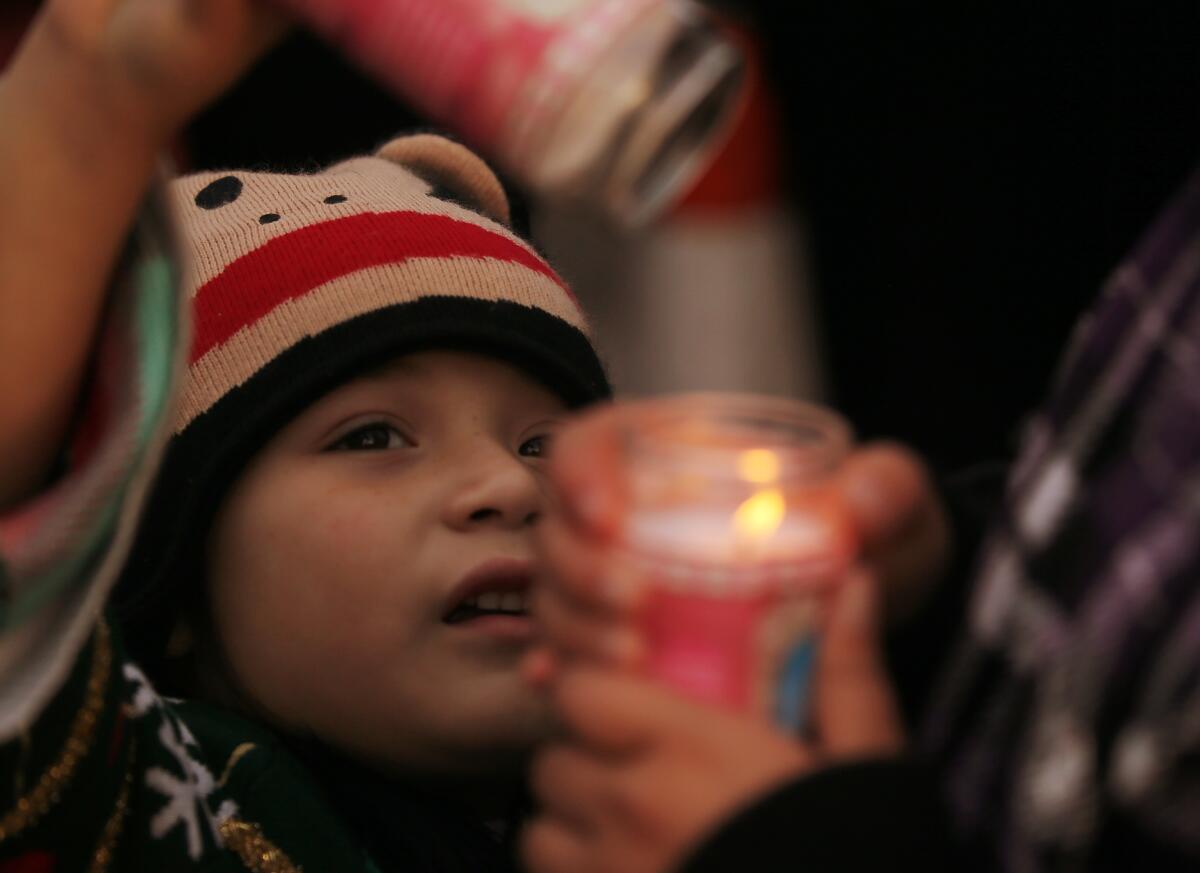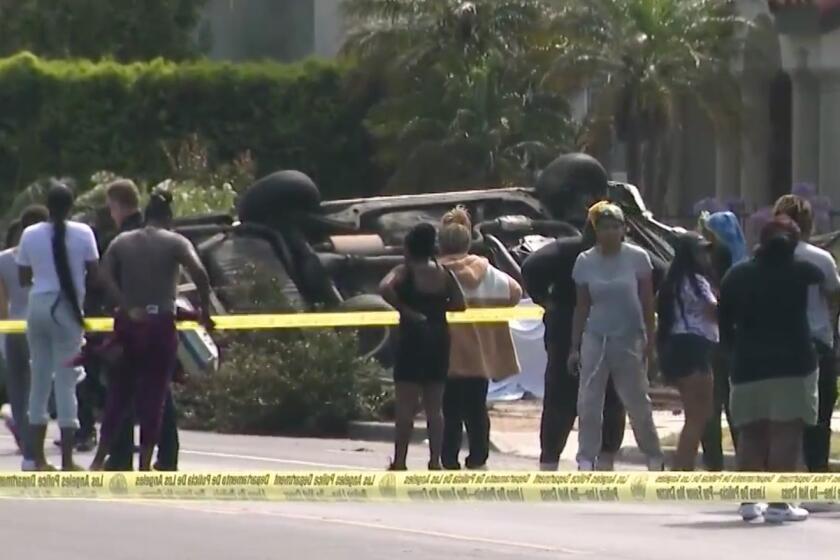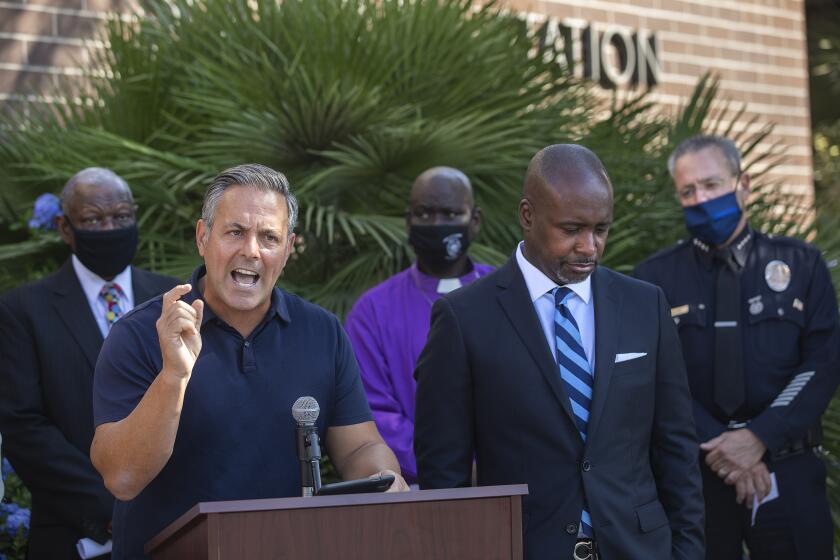Editorial: Let’s be honest — and smart — about the increase of homicides in L.A.

- Share via
Los Angeles is soon to close out its second consecutive year of rising homicide, with the largest number of killings in more than a decade. Fatal shootings of children in the holiday season can seem especially cruel; the killings in December in L.A. include a 14-year-old boy outside a Boyle Heights recreation center on Dec. 7, and a 12-year-old boy outside a Wilmington elementary school on Dec. 6.
We now must reckon as well with the killing of a 14-year-old girl, shot dead in a dressing room at a Burlington store in North Hollywood on Dec. 23. This death is different in that it was caused by a police officer shooting at a suspect, who was armed with a bicycle lock, not a gun; yet it is tragically intertwined with the ongoing debate about whether police keep people safe more than they cause them harm.
The jump in killings is sobering. Just two years ago, California marked its lowest-ever recorded crime rate and L.A. completed the 10th straight year in which homicides fell short of 300. But that remission has ended, and we’re in danger of reaching 400 homicides by the end of the year. The city is in the midst of twin pandemics, both deadly, one killing us with a virus and the other, most often, with bullets.
The best first step in dealing with L.A.’s murder pandemic is to remember the tough lessons learned the last time around.
There are multiple ways to go wrong in responding to such violence, and one is to deny or minimize it. Violence surely affects not just the dead, their families and their neighborhoods. It extends outside city limits and across age and socioeconomic lines to include victims like philanthropist Jacqueline Avant, 81, fatally shot in her Beverly Hills home. While violent attacks kill, they also wound, as is the case with a 9-year-old girl on a playground and an adult woman in a car, injured in the Wilmington shooting. Homicides affect our economy, our quality of life and our collective psyche, all things that were already under the cruel assault of COVID-19. We must treat with care and compassion those most directly affected. We must stop the spread. We must shun quack remedies and conspiracy theories and develop treatments that work. We must find a lasting cure.
It stands to reason that many of us will ask, “Who (or what) did this?” And it’s a fair question. We won’t solve the problem of rising homicide rates without knowing its cause. Yet some in law enforcement, in elected office and elsewhere blame the increase in homicide, as they blame all crime, on criminal justice reform measures in California —which are not the cause. A higher level of thinking is in order.
Experience and data teach us that public safety and public health are intimately linked and that one is not possible without the other. They teach us that the ingredients for both include properly selected, trained and supervised police, in adequate numbers, because public health officials and police both deal with fallout from the same community problems — mental health breakdowns, substance abuse, inadequate housing, education and employment.
Police must be able to recognize public health issues and work closely enough with health officials to refer problems to them. They teach us that police are just one part of the equation, and that we cannot expect them to see to our safety alone, any more than doctors or nurses can stop the coronavirus without medical researchers, public health specialists or our own good sense to get inoculated and protect one another with masks at the appropriate time and place.
L.A.’s most injured neighborhoods need exactly what they needed 30 years ago and did not get, including a more responsive, more respectful police force.
Experience also reminds us that without the proper selection, training, tactics and supervision, police can be part of the problem we hire them to solve. Consider, for example, the Long Beach school safety officer charged with murder for killing an 18-year-old woman when he fired his gun at a car in September. Or the former Brooklyn Center, Minn., police officer recently convicted of manslaughter for the killing of Daunte Wright in April while allegedly mistaking her gun for a Taser. Or ex-Minneapolis Officer Derek Chauvin, who killed George Floyd a year earlier.
And now, tragically, the LAPD officer who shot a round that went through a dressing room wall at the Burlington store, killing 14-year-old Valentina Orellana-Peralta.
Los Angeles is not the entire universe. Homicides here are rising, but not as quickly as in other major U.S. cities. Our 51% increase over the last two years compares with a 60% jump in Chicago, 78% in Houston, 109% in Portland, Ore. Yet the misery of other cities offers no comfort.
Some social scientists have argued that crime is like a social contagion, one that can spread through communities. There’s dispute about that. What’s indisputable is that both health and homicide crises require a comprehensive response.
Both can easily, without wisdom, leadership and compassion, cloud our thinking. We can’t afford that. Not if we want to end this scourge and get back on the path toward health and safety.
More to Read
A cure for the common opinion
Get thought-provoking perspectives with our weekly newsletter.
You may occasionally receive promotional content from the Los Angeles Times.












